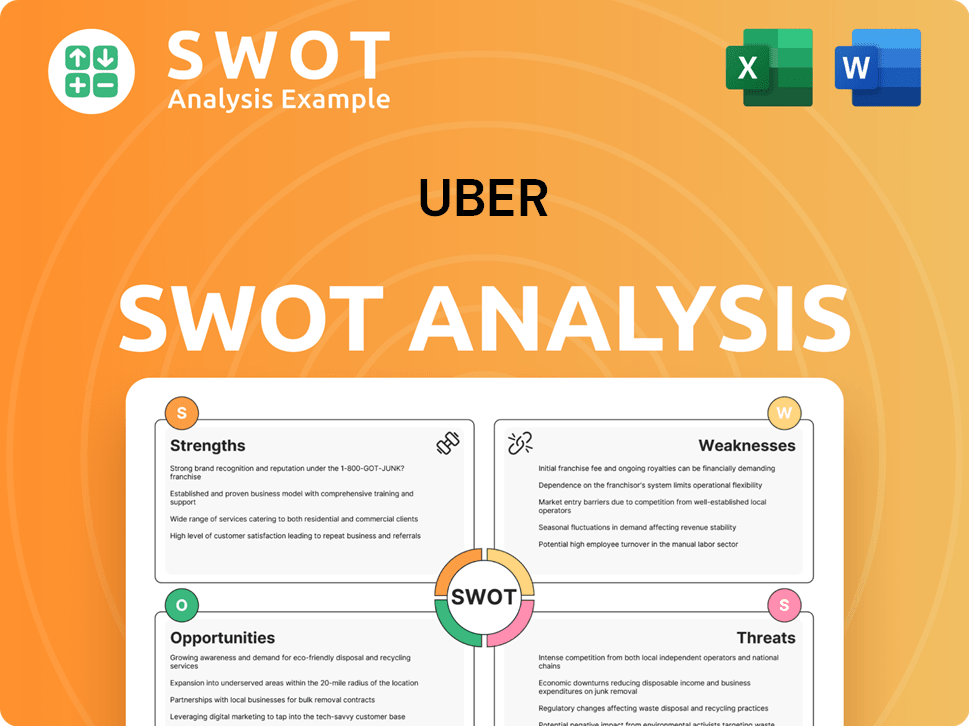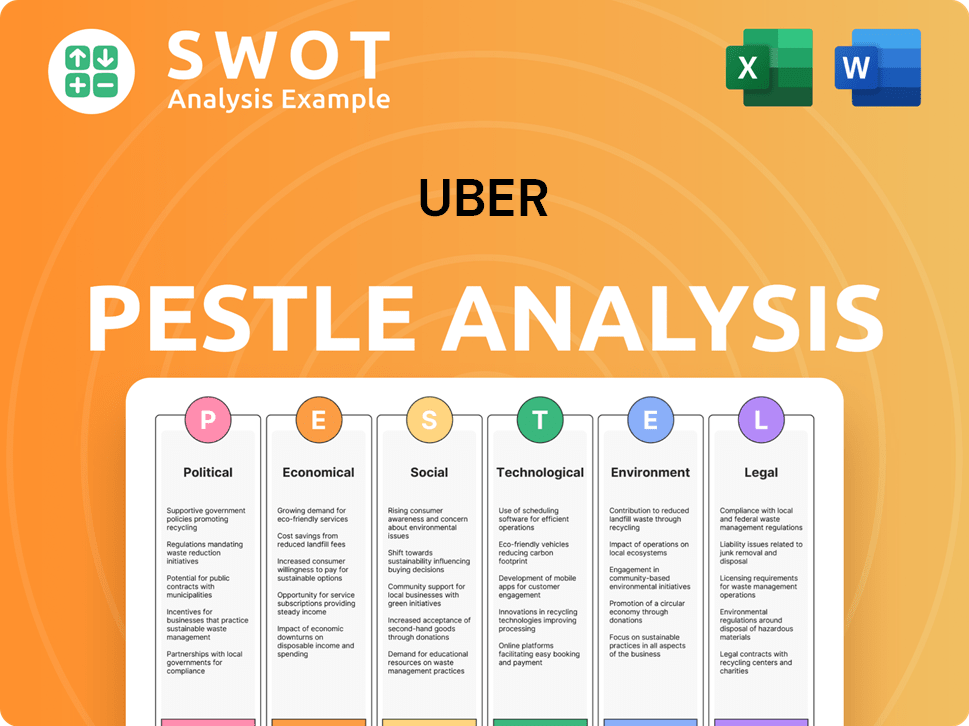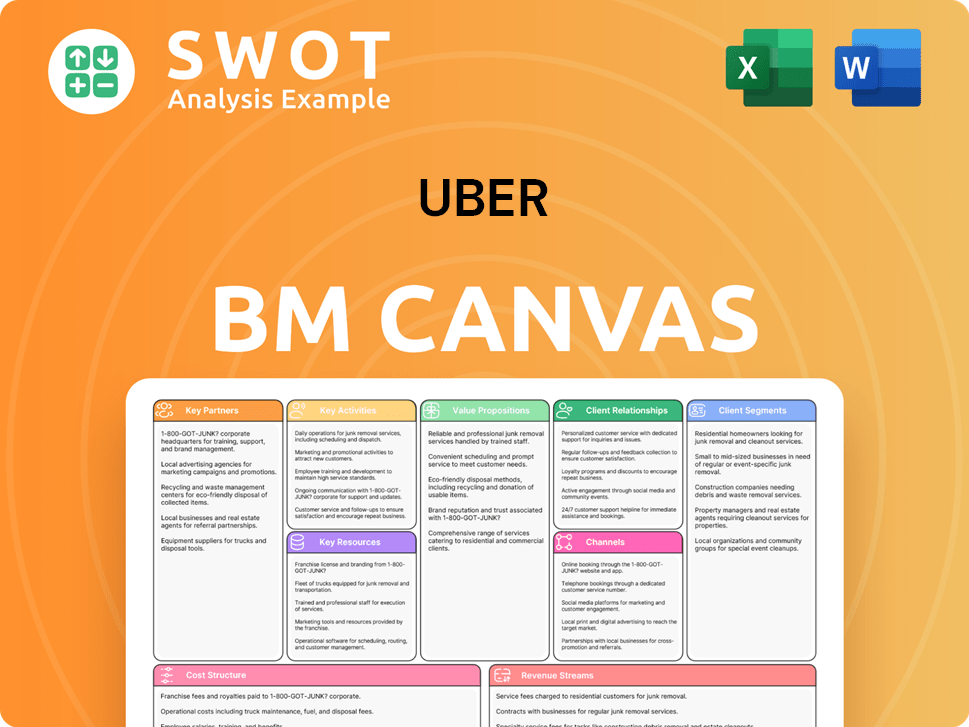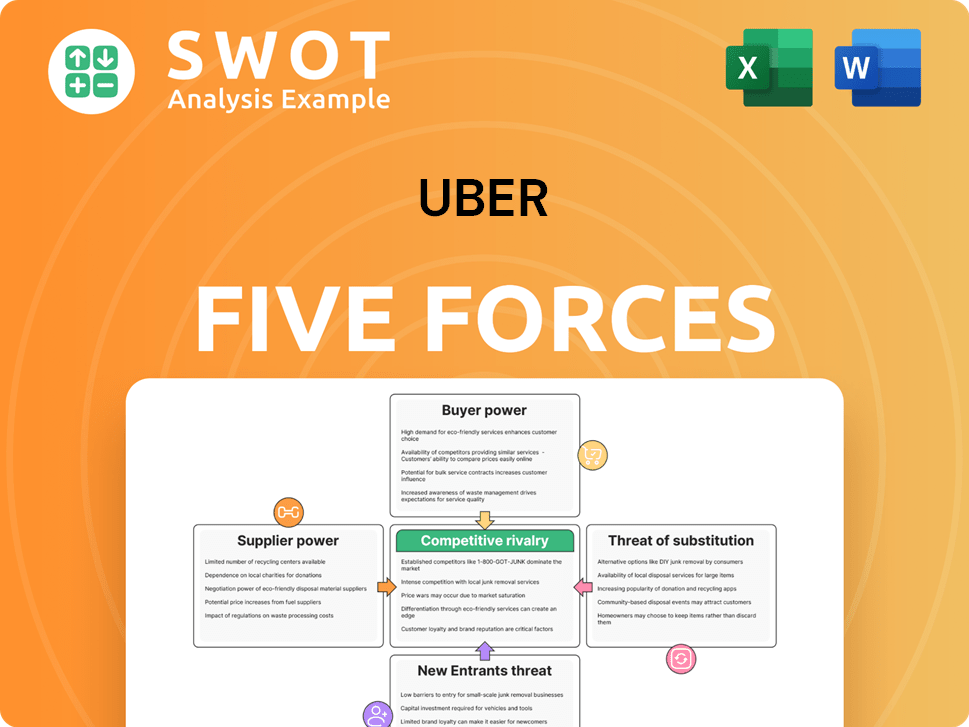Uber Bundle
Can Uber Maintain Its Dominance?
Born from a simple need in 2008, Uber revolutionized transportation, evolving from a black car service to a global mobility giant. Today, with a market cap of $175 billion as of June 3, 2025, Uber facilitates millions of trips daily across 70 countries. But what does the future hold for this transportation titan?

This exploration delves into the Uber SWOT Analysis, examining its ambitious Uber growth strategy and the complex landscape of the ride-sharing market. We'll analyze the Uber company's expansion initiatives, technological advancements, and financial outlook to understand its Uber future prospects within the dynamic transportation industry. Understanding Uber's business expansion and strategic moves is crucial for anyone looking to understand the future of mobility.
How Is Uber Expanding Its Reach?
The Uber growth strategy is built on aggressive expansion, targeting new markets and diversifying its service offerings. This approach allows the company to reach more customers and increase its overall market share. Currently, the company operates in approximately 70 countries and 15,000 cities worldwide, showcasing its extensive global presence.
A key focus for Uber is expanding beyond its core ride-hailing services. This includes significant investments in food and grocery delivery, partnerships, and the development of autonomous vehicle technology. By diversifying its offerings, Uber aims to capture a larger share of the transportation and delivery markets, driving revenue growth and enhancing its long-term prospects.
The company's expansion initiatives also involve strategic partnerships and acquisitions. Uber carefully evaluates opportunities that align with its strategic goals, ensuring that any new ventures contribute to its overall growth and market position. This approach helps Uber stay competitive and adapt to the evolving demands of the transportation and delivery industries.
Uber is expanding its services beyond ride-hailing. Uber Eats has become a significant growth engine, with revenue increasing from $12.1 billion in 2023 to $13.7 billion in 2024. The company is also venturing into grocery and retail delivery, partnering with companies like Wegmans and The Home Depot to broaden its service offerings.
Uber is actively pursuing autonomous vehicle (AV) partnerships to expand its business model. It is collaborating with WeRide to launch autonomous mobility services in Abu Dhabi. The company is also accelerating its AV roadmap with partners like NVIDIA and Momenta, with self-driving taxis expected to debut in Texas by late 2025.
Uber focuses on strategic partnerships to enhance its market position. The company is expanding its 'Uber for Teens' service and introducing consumer shuttles in the U.S. It continues to deepen its taxi partnerships globally. Uber maintains a high bar for mergers and acquisitions, focusing on opportunities that align with its strategic goals.
A new venture into beauty delivery with Sally Beauty is projected to add $1 billion to Uber's top line by 2026. This expansion into new sectors demonstrates Uber's commitment to diversifying its revenue streams and capturing a larger share of the market. The company's strategic moves aim to ensure sustainable growth and adaptability in the rapidly evolving transportation industry.
Uber's expansion strategy involves entering new markets, diversifying services, and forming strategic partnerships. These initiatives are designed to increase market share and revenue. This includes exploring new business models and technological advancements, such as autonomous vehicles.
- Entering new cities and countries to increase its global footprint.
- Expanding into food, grocery, and retail delivery services.
- Partnering with companies to offer new services, such as beauty product delivery.
- Investing in autonomous vehicle technology for future transportation solutions.
- Deepening taxi partnerships to broaden its service offerings.
For a deeper understanding of the competitive landscape, including Uber's position within the ride-sharing market, consider exploring the Competitors Landscape of Uber. This provides valuable insights into the strategies and challenges faced by Uber and its competitors in the transportation industry.
Uber SWOT Analysis
- Complete SWOT Breakdown
- Fully Customizable
- Editable in Excel & Word
- Professional Formatting
- Investor-Ready Format

How Does Uber Invest in Innovation?
The company's innovation and technology strategy is a core driver of its sustained growth. It heavily invests in digital transformation, automation, and advanced technologies like artificial intelligence and autonomous vehicles. These efforts are crucial for maintaining its competitive edge in the ride-sharing market and broader transportation industry.
The company's commitment to innovation is evident in its substantial research and development spending. These investments are vital for shaping the future of transportation and expanding its business. The company's approach to innovation is designed to meet evolving customer needs and preferences, ensuring its long-term viability.
The company's strategic focus on innovation and technology is integral to its long-term business model, enabling it to adapt to market changes and maintain its position as a leader in the transportation industry.
The company's research and development expenses for the twelve months ending March 31, 2025, reached $3.134 billion. For the full year 2024, R&D expenses were $3.109 billion, demonstrating a consistent commitment to technological advancement.
The company is actively pursuing autonomous vehicle (AV) technology through strategic partnerships. Collaborations with companies like NVIDIA are designed to accelerate autonomous mobility and develop AI-driven systems.
The company's shift towards a partnership-driven approach to AV technology is a key aspect of its strategy. This includes partnering with Waymo for self-driving technology, offering a potentially capital-efficient path to innovation.
The company aims to cut driver costs by 40% by 2030 through its autonomous vehicle initiatives. This ambitious target highlights the potential impact of AV technology on its profitability and operational efficiency.
The company focuses on product innovation to boost demand and enhance its platform, improving its position for both existing and new customers. This includes broadening Mobility use cases and price segmentation.
Examples of product innovation include the launch of Uber Business Black, which reimagines the premium car service experience, and enhancements to Uber One. These initiatives are designed to cater to different customer segments and preferences.
The company's commitment to innovation is further demonstrated by its extensive patent portfolio. As of April 23, 2025, the company holds a total of 3060 patents globally, with 1832 active patents, reflecting its investment in intellectual property.
- Recent patents granted in 2025 include 'Computer system arranging transport services for users based on the estimated time of arrival information' (May 6, 2025) and 'On-demand transport services' (April 15, 2025).
- These patents cover a wide range of areas, including systems for detecting non-compliant use of micro-mobility vehicles and dynamic scheduling systems for service requests.
- The company's patent portfolio supports its competitive advantages and contributes to its long-term growth strategy.
The company is committed to sustainability, aiming to become a fully electric, zero-emission mobility platform by 2040 globally. The company's sustainability initiatives are a key part of its long-term strategy, aligning with global environmental goals.
- The company has set a target of 100% zero-emission rides in the U.S., Canada, and Europe by 2030.
- The company achieved a 100% renewable energy match in its U.S. offices in 2023, demonstrating its commitment to reducing its carbon footprint.
- These sustainability efforts are designed to enhance the company's brand image and appeal to environmentally conscious consumers.
For more insights into the company's business model and revenue streams, you can explore Revenue Streams & Business Model of Uber.
Uber PESTLE Analysis
- Covers All 6 PESTLE Categories
- No Research Needed – Save Hours of Work
- Built by Experts, Trusted by Consultants
- Instant Download, Ready to Use
- 100% Editable, Fully Customizable

What Is Uber’s Growth Forecast?
The financial outlook for the ride-sharing market, particularly for , shows a significant shift towards profitability and sustainable growth. The company has demonstrated a strong ability to increase revenue and manage costs effectively. This has led to positive financial results and a more stable financial position.
The company's transition from a growth-focused strategy to one that emphasizes profitability is evident in its recent financial performance. This strategic shift is critical for long-term success and positions the company well within the competitive transportation industry. The company's focus on financial discipline and operational efficiency is paying off.
The company's financial performance is a key indicator of its future prospects. The company's ability to generate substantial revenue and manage expenses is crucial for its continued success and expansion. This financial stability allows the company to invest in new technologies, expand into new markets, and enhance its services, which is critical for its long-term business model.
In 2024, the company's revenue reached $43.98 billion, marking a 17.96% increase from the $37.28 billion in 2023. Analysts project continued revenue growth, with an average estimate of $50.56 billion for 2025 and $57.69 billion for 2026. The company's revenue streams are diversified, contributing to its financial stability.
The company reported a net income of nearly $10 billion for the fiscal year ending December 31, 2024, a significant improvement from losses in previous years. Operating income rose to $2.8 billion in 2024, a 152.25% increase. This demonstrates the company's improved profitability outlook.
The company's free cash flow (FCF) more than doubled, reaching $6.89 billion in 2024, up from $3.36 billion in 2023. This robust FCF generation provides financial flexibility for strategic initiatives. The company's strong FCF generation supports its expansion into new markets.
The debt-to-equity ratio improved to 0.46x as of December 2024, indicating enhanced financial stability. The company executed common stock repurchases of $1.25 billion in 2024. This demonstrates the company's commitment to financial discipline and shareholder value.
The company's long-term financial goals include a 10% CAGR for revenue and adjusted EBITDA over the next five years. This could lead to revenue of $81.5 billion and adjusted EBITDA of $13.9 billion by 2030. The company is focused on sustainable growth and market share analysis.
- Q1 2025 revenue was $11.5 billion, a 14% year-over-year increase.
- Q1 2025 income from operations was $1.2 billion.
- Q1 2025 Adjusted EBITDA grew 35% year-over-year to $1.9 billion.
- For Q2 2025, the company anticipates Gross Bookings of $45.75 billion to $47.25 billion.
- Q2 2025 Adjusted EBITDA is projected to be $2.02 billion to $2.12 billion.
For an in-depth look at the company's ownership structure and financial strategies, consider exploring Owners & Shareholders of Uber.
Uber Business Model Canvas
- Complete 9-Block Business Model Canvas
- Effortlessly Communicate Your Business Strategy
- Investor-Ready BMC Format
- 100% Editable and Customizable
- Clear and Structured Layout

What Risks Could Slow Uber’s Growth?
The path forward for the ride-sharing giant, faces several potential hurdles that could impact its ambitious growth plans. These challenges span from intense competition and regulatory pressures to technological disruptions and macroeconomic uncertainties. Understanding these risks is crucial for assessing the long-term viability and success of the Uber growth strategy.
Competition in the ride-sharing market and the broader transportation industry remains fierce, with rivals constantly vying for market share. Moreover, regulatory changes, particularly regarding driver classification, pose a significant and ongoing challenge. The company must navigate these complexities to maintain its position and achieve its Uber future prospects.
Technological advancements, especially in autonomous vehicles (AVs), present both opportunities and risks. Successfully integrating AVs is crucial for maintaining a competitive edge. Other risks include managing growth, retaining drivers, and macroeconomic factors.
The ride-sharing market is highly competitive. Key competitors include Lyft and DoorDash, along with regional players. In the U.S., while Uber company holds a dominant position in ride-hailing, DoorDash leads in food delivery, highlighting the need for strategic diversification.
Regulatory changes are a constant concern. Driver classification as employees versus independent contractors is a global issue. In early 2025, the U.S. FTC required reclassification of drivers in some states, costing the company $200 million. Antitrust probes and new tax reporting requirements further complicate matters.
The development of autonomous vehicles (AVs) presents both opportunities and risks. Failure to integrate AVs effectively could lead to market share loss. The development of AV technology is capital-intensive and faces regulatory hurdles.
Managing growth and corporate culture, attracting and retaining drivers, and maintaining brand reputation are significant challenges. Macroeconomic factors such as inflation and interest rates can also impact performance.
The company aims to mitigate these risks through service diversification, strategic partnerships, and operational efficiency. Disciplined capital allocation is also key to navigating these challenges. Understanding the Uber's challenges and opportunities is key.
The company faces scrutiny from regulatory bodies. In 2024, the U.S. FTC settled a case for $20 million due to misleading driver earnings claims. Antitrust investigations into potential collusion further complicate the legal landscape. For more information, read about Mission, Vision & Core Values of Uber.
The company holds a significant market share in the ride-hailing sector. However, it faces stiff competition in food delivery. DoorDash has a larger U.S. market share. Regional players also compete, intensifying the need for strategic initiatives.
Reclassifying drivers can significantly increase operational costs. The FTC's actions in early 2025 highlight the financial impact. New tax reporting requirements for digital platforms create additional compliance burdens. These regulations impact the Uber's regulatory environment.
Failure to integrate autonomous vehicles could result in a loss of market share. Managing rapid growth and maintaining a positive corporate culture are also critical. Attracting and retaining drivers remains a key challenge. The Uber's technological advancements are key.
Economic factors such as inflation and interest rates can affect profitability. Diversification of services and strategic partnerships are key to mitigating these risks. The company focuses on operational efficiency and disciplined capital allocation. This is part of the Uber's strategic partnerships.
Uber Porter's Five Forces Analysis
- Covers All 5 Competitive Forces in Detail
- Structured for Consultants, Students, and Founders
- 100% Editable in Microsoft Word & Excel
- Instant Digital Download – Use Immediately
- Compatible with Mac & PC – Fully Unlocked

Related Blogs
- What are Mission Vision & Core Values of Uber Company?
- What is Competitive Landscape of Uber Company?
- How Does Uber Company Work?
- What is Sales and Marketing Strategy of Uber Company?
- What is Brief History of Uber Company?
- Who Owns Uber Company?
- What is Customer Demographics and Target Market of Uber Company?
Disclaimer
All information, articles, and product details provided on this website are for general informational and educational purposes only. We do not claim any ownership over, nor do we intend to infringe upon, any trademarks, copyrights, logos, brand names, or other intellectual property mentioned or depicted on this site. Such intellectual property remains the property of its respective owners, and any references here are made solely for identification or informational purposes, without implying any affiliation, endorsement, or partnership.
We make no representations or warranties, express or implied, regarding the accuracy, completeness, or suitability of any content or products presented. Nothing on this website should be construed as legal, tax, investment, financial, medical, or other professional advice. In addition, no part of this site—including articles or product references—constitutes a solicitation, recommendation, endorsement, advertisement, or offer to buy or sell any securities, franchises, or other financial instruments, particularly in jurisdictions where such activity would be unlawful.
All content is of a general nature and may not address the specific circumstances of any individual or entity. It is not a substitute for professional advice or services. Any actions you take based on the information provided here are strictly at your own risk. You accept full responsibility for any decisions or outcomes arising from your use of this website and agree to release us from any liability in connection with your use of, or reliance upon, the content or products found herein.